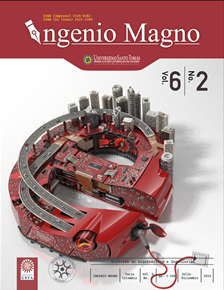DRAM size independence in single-core processors using gem5
Contenido principal del artículo
Resumen
Descargas
Detalles del artículo
DECLARACIÓN DE ORIGINALIDAD DE ARTÍCULO PRESENTADO
Por medio del presente documento, certifico(amos) que el artículo que se presenta para posible publicación en la revista institucional INGENIO MAGNO del Centro de Investigaciones de Ingeniería Alberto Magno CIIAM de la Universidad Santo Tomás, seccional Tunja, es de mi (nuestra) entera autoría, siendo su contenido producto de mi (nuestra) directa contribución intelectual y aporte al conocimiento.
Todos los datos y referencias a publicaciones hechas están debidamente identificados con su respectiva nota bibliográfica y en las citas que se destacan como tal. De requerir alguna clase de ajuste o corrección, comunicaré(emos) de tal procedimiento con antelación a los responsables de la revista.
Por lo anteriormente expresado, declaro(amos) que el material presentado en su totalidad se encuentra conforme a la legislación aplicable en materia de propiedad intelectual e industrial de ser el caso, y por lo tanto, me(nos) hago (hacemos) absolutamente responsable(s) de cualquier reclamación relacionada a esta.
En caso que el artículo presentado sea publicado, manifiesto(amos) que cedo(emos) plenamente a la Universidad Santo Tomás, seccional Tunja, los derechos de reproducción del mismo.
Citas
ARM (2013). Cortex A8 Technical Reference Manual. Revision: R2p1. http://infocenter.arm.com/help/index. jsp?topic=/com.arm.doc.ddi0344i/index.html (2013).
C. Augustine, C., X. Mojumder, X, H. Fong, H, S. Choday, S., P. Park, P. and & K. Roy, K. (2012). STT-MRAMs for future universal memories: perspective and prospective. Proc. of 2012 28th Int. Conf. on Microelectronics, 349355.
Inc. Cadence Design Systems (2013a). Cadence design ip: Wide-i/o controller. Tech. Rep.
Inc. Cadence Design Systems (2013b). Sources of error in full-system simulation. Advanced Computer Architecture Laboratory, Michigan: University of Michigan, Advanced Computer Architecture Laboratory..
Fernando Endo, F., Damien Couroussé, D. & and Charles, H.P.. Henri-Pierre (2014). Microarchitectural simulation of in-order and out-of-order arm microprocessors with gem5. International Conference on Embedded Computer Systems: Architectures, Modeling, and Simulation (SAMOS XIV).
Xuanyao Fong, X. and& Kaushik Roy, K. (2013). Lowpower robust complementary polarizer STT-MRAM (CPSTT) for on-chip caches. West Lafayette: Purdue University.
Hansson, A., Agarwal, N., Kolli, A., Wenisch, T. & and Udipi, A. (2014). Simulating dram controllers for future system architecture exploration. Proceedings of the International Symposium on Performance Analysis of Systems and Software (ISPASS).
David Money Harris, D. and& Sarah L. Harris, S. (2007).. Digital Design and Computer Architecture. California: Elsevier., inc.1, 2007.
John Hennessy, H. and& David. Patterson, D. . Computer Organization and Design (2009). The hardware software interface (4th ed.). California. Elsevier inc.
Hennessy, H. & Patterson, D. (2012). Computer architecture: a quantitative approach (2012). (5th ed.). John Hennessy and David. Patterson. California:. Elsevier inc.
Jacob, B. and D. Wang, D. (2007). Memory Systems: Cache, DRAM, Disk. (2007). B. California:. Morgan Kaufmann Publishers Inc.
Jain, P. rachi and& Wadhawan, J. anakrani (2014). Desing and comparative analysis of SRAM cell structures using 0.5 nm technology. International Journal of Computer Applications, 87(3)..
Rainer Leupers, R. and& Olivier Temam, O. (2007). .Processor and system-on- chip simulation. (2007). USA. Springer.
Nathan, B. et al. (2011). The gem5 Simulator. (2011). Recuperado de http://research.cs.wisc.edu/multifacet/ papers/can11_gem5.pdfACM SIGARCH Computar Architecture News.
Wulf, M. (1995). cKee. Hitting the memory wall: implications of the obvious. (1995). USA. Computer Architecture News, 23, 20-24.

